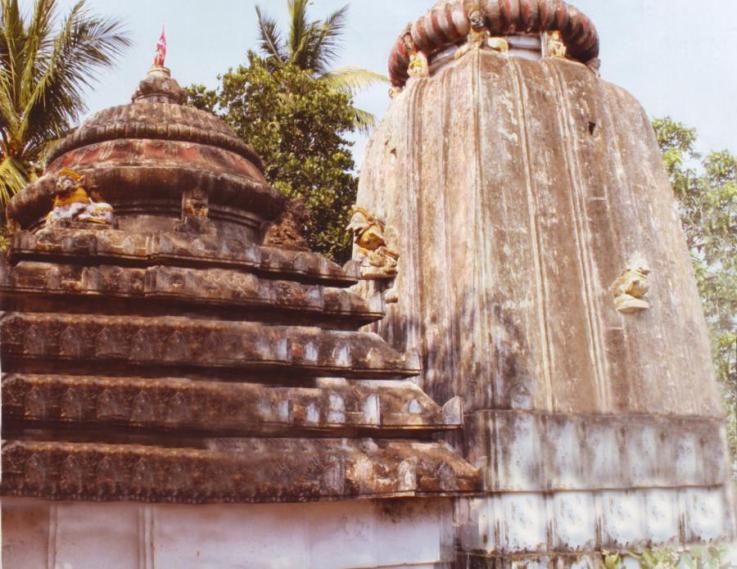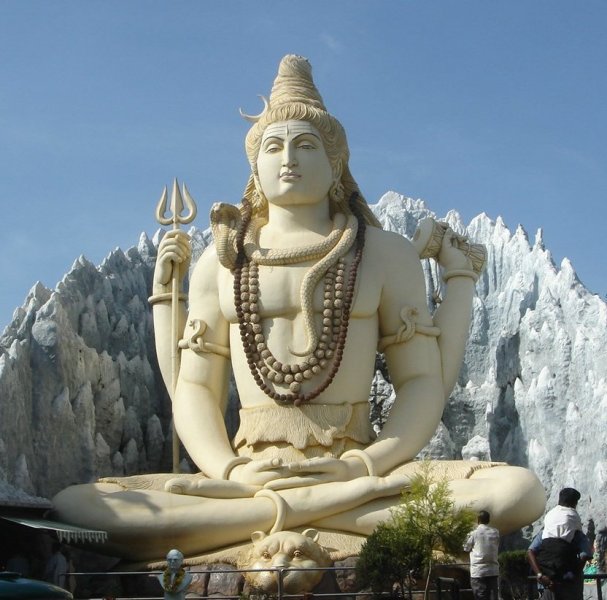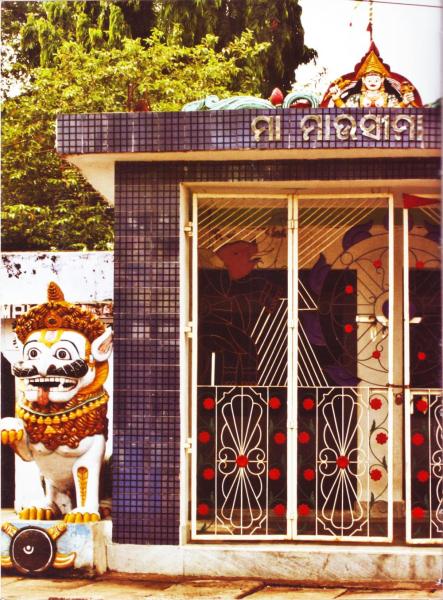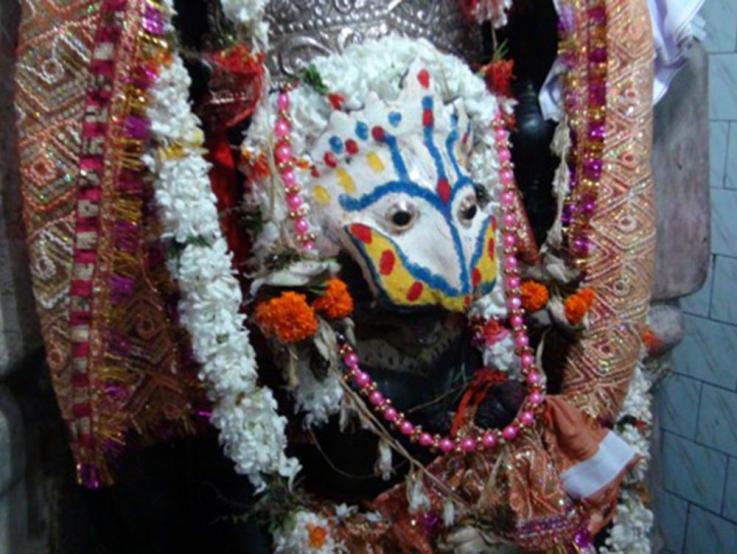
Alam Chandi Temple
The Alamchandi Temple is situated in the Kumbharpada area of Puri. It is located on the left side of the Puri-Bhubaneswar road leading from Hospital square towards Atharanala bridge. The temple is facing towards east and the presiding deity is Goddess Alamchandi. Alamchandi is one of the Asta (Eight) Chandis of Puri. Alam Chandi is worshipped here in her four handed Durga form.
Alam Chandi temple is closely associated with the Navakalevara festival of Lord Jagannatha Temple. Alam Chandi is present at the entrance to the Puri town. During Navakalevara festival, the carts loaded with the sacred Daru (wooden logs) are brought into Puri via the road in front of Alam Chandi temple. Maharaj Gajapati and other great sadhus come here to receive the daru in a great procession.
Asta Mahavira Temples
There are Asta (eight) Hanuman (or Mahaviras) who are engaged in protecting Puri Dhama.
They are Siddha Mahavira, Daria Mahavira or Bedi Mahavira, Kanapata Mahavira, Vargi Mahavira, Masani Mahavira, Pancha Mukhi Mahavira, Phate Mahavira.
For the protection of Sri Mandir (Jagannatha Temple), Hanuman also guards the four directions of the temple.
At the Lion’s gate,eastern gate, is Phate Hanuman; at the western gate is Vira Vikrama Hanuman; at the northen gate Tapasvi Hanuman; and at the southern gate Kanapata Hanuman and Bada Bhai Hanuman.
Siddha Hanuman: The temple of Siddha Mahavir is situated at a distance of about 1Km to the north-east of the Gundicha temple of Puri. This is a small temple dedicated to Lord Hanuman. It is one of the important shrines of Puri. Tulasi Das, the famous author of Rama Charita Manasa, stayed here for some time when he visited Puri. The shrine of Siddha-Mahavir is an important place, where the presiding deity is greatly revered by the local people. The image of Lord Mahavir (Hanuman), the presiding deity of the temple, is about 6 feet in height. He holds gada (club) in left hand and a massive rock boulder (Gandha-Mardana Mountain) in right hand. The deity has been installed on a decorated pedestal of 2 feet high.
There is a beautiful pond in front of the temple. Devotees wash their hands and feets in this pond before entering into the temple. Festivals like Makara Sankranti, Rama Navami, Dola Purnima are observed in this temple with great interest.
Kanapata Hanuman: Kanapata Hanuman is located on the western gate of Jagannatha Temple (Vyaghra dvara). After marrying Laxmi devi who is the daughter of the ocean, the Lord became the son-in-law of the ocean .
During the night the waves of the ocean make a loud sound that is heard all over Puri. One time this sound entered Jagannatha’s temple, thus disturbing the Lord’s sleep. Lord Jagannatha ordered Samudra not to make any sound which might disturb Him. Since then, the sound of Samudra crashing on the beach never again entered Jagannatha’s Temple. Lord Jagannatha engaged His devotee Hanuman to stand at the south gate and listen attentively and ensure the sound never entered the mandira. “Kanapata” means to engage the ears (kana) for hearing. Thus Hanuman is known here as Kanapata Hanuman.
Vargi Hanuman: The temple is situated on Lokanatha road towards the west of Jagannatha Temple. Formerly, Vargis a clan from Maharashtra would pass through this way on their horse, creating a disturbance to the temple and the people of puri. These Vargis were devoted to Hanuman, and so to stop them entering Puri a Hanuman Murti was kept in this area. The Vargis were reluctant to pass the Hanuman murti, thus Puri was protected from the attack of the Vargis from Maharashtra.
Bedi Hanuman: The Bedi Hanuman temple is situated on the left side of the Chakratirtha road leading from Subash Bose Chowk to Penthakata. Lord Jagannatha engaged Hanuman to protect Puri Dham from His father-in-law, Ocean. Because sometimes the ocean waves would enter Puri and people would suffer. Thus Hanuman was posted here by Jagannatha to guard so that the ocean waves could not enter the town.
One time, however Hanuman left this place, without informing Lord Jagannatha to visit Ayodhya. As a result the ocean waves entered the town and the people were in great distress. Lord Jagannatha brought Hanuman back from Ayodhya and bound him with the rope or bedi, ordered him to never leave this place and do his duty nicely. Hanumanji left this place as everyday he would be only fed with Khichadi prasadam. Wanting to relish delicious food he secretly had visited ayodhya at night.
After this whole incident, Lord Jagannath ordered his servants to supply special mahaprasadam for Hanumanji daily. Even today this deity of Hanuman is offered special laddus in the temple.
Because Hanuman is situated near the ocean (daria) He is also known as Daria Hanuman.
Panchamukhi Hanuman: The western side of Gundicha temple and on the bank of sacred Indradyumna tank, there is a temple known as the Panchamukhi Hanuman Temple.
The presiding deity is Panchamukhi Hanuman. The deity has five faces; Varaha in north, Narasimha in south, Hanuman in east, Garuda in west and Hayagriba in top. The image has ten hands, holding sankha, trident, khatwanga, pasa, ankusa, hillock, dhuma, musthi, mace and snake. He is standing over the demon.
Tapasvi Hanuman: This Hanuman deity is located at the north gate of Sri Jagannatha temple for the protection of the mandira. He is also known as Cari-cakra means he is holding four cakras in his hands. This deity of Hanuman is four feet in height and faces east.

Asta Sambhus or Mahadevas
According to the Skanda Purana there are Asta Sambhus, or eight Mahadevas, in Sri Ksetra:
Kapala Mochana, Lokanatha Mahadeva, Kameshvara, Ksetrapala, Yameshvara, Markandeshvara, Isaneshvara, Visveshvara and Nilakantheshvara.
Sri Kapala Mochana Mahadeva: The Kapala Mochana Mahadeva is situated near the horse gate (southern gate) of the Sri Jagannatha Temple, and it is forty feet under the ground. The temple is located on the left side of Gandua Chaura Chowk in Manikarnika Street.
Initially Brahma had five heads. Lord Shiva slapped one of those head, and the Kapala (Head of Brahma) remained attached to lord Shiva’s hand, thus he committed the sin of killing a brahmana. He could not get rid of it and went everywhere but this sin followed him. Finally, when lord Shiva was passing through Puri Dham, suddenly the Kapala fell from his hand. Thus the mercy of Jagannatha and the power of Sri Ksetra Dham, Shiva become free from his sin, and so this deity is known as Kapala Mochana Mahadeva, meaning “Mahadeva from whose hand the head fell.”
He is one of the five Shiva’s who Protect Puri Dham, and is known as Nakula of the Pandavas. Kapala Mochana Temple is associated with several festival of Jagannatha temple, like Chandan Yatra festival, Sitalasasti, Dolapurnima and Rudravisekha of Lord Jagannath Temple.
Sri Lokanatha Mahadeva: This temple is situated on the south west side of the Jagannatha Temple on the Lokanatha Road. Sri Lokanatha Mahadeva is one of five dvara palas of Puri Dham and the main among the five Mahadevas. These five Mahadevas are also known as the five Pandavas; He is known as Bhimasena.
The innermost chamber of the main temple preserves a Shiva linga which is the presiding deity of the temple. This linga is visible to the devotees once in every year. The sanctum including the linga is filled with water throughout the year by a natural fountain. In the night of Pankoddhar Ekadashi (3 days before the famous Shivaratri festival) all the water is bailed out and the Shiva Linga becomes visible and thousands of devotees are able to worship the Lord directly.
Nilakantheshvara Mahadeva: This is situated in the far east of Jagannatha puri, on the bank of Indradyumna Sarovara behind Gundicha Temple. Nilakanthesvara Mahadeva is one of the Pancha Shiva and Asta Sambhu who guard Puri Dham. He is also known as the Pandava brother Sahadeva.
Yameshvara Mahadeva: Here Lord Shiva is known as Yameshvara Mahadeva because he controls Yamraja. This is situated in Yameshvara Tota, North of Tota Gopinatha temple and south of Jagannatha temple at the end of Harachandi Sahi. The temple is about forty feet ground level. This place is also known as Yavanika Tirtha. The Vijaya Vigraha of Sri Yameshvara Mahadeva is a Hari-Hara Murti. This murti goes to Jagannatha temple on different occasion.
He is also understood to be the eldest brother of the Pandavas, Maharaja Yudhisthira.
Markandeshvara Mahadeva: The ancient Markandeshvara Shiva Temple is situated in the Markandeshvar Street by the side of the Markandeshvara tank, to the north of the Jagannatha temple. This place can be approached on the right side of Markandeshvara road leading from Markandeshvara chowk to Puri-Brahmagiri road. Markandeya Muni resides here and worships Lord Shiva. This temple is facing towards east and the presiding deity is a Sivalinga. He is the Arjuna among five Pandavas.
Markandeya tank: Markandeya tank is an open structure and it enclosed within a stone wall made of dressed laterite blocks. After taking bath in Markandeya Sarovara one should take darshana of Markandeshvara Mahadeva, which gives the result of performing a Rajasuya Yagya and Ashvamedha Yagya.

Mausi Ma Mandira
In Orissa “Mausi Ma” means aunty. The temple is situated almost the mid way of the Grand road, a small temple of the Goddess Ardhasini otherwise called as Mausima of Lord Jagannath. During return of Ratha yatra all chariots stop here at Mausi Ma Mandira and the deities are offered Poda Pitha, a kind of cake.
Swargadvara
Svargadvara means doorway to Heaven.It is situated on the oceanfront. There is a road from Jagannatha temple to Svargadvara called Bali Sahi Road. At this place, demigods from the heavenly planets enter puri to take darshan of Lord Jagannatha. By the prayer of King Indradyumna, Brahma came to this place with demigod. On every Amavasya tithi, Lord Jagannatha comes to Svargadvara in His Narayana form to take bath in Mahodadhi (the great ocean).

Sveta Ganga
Sveta Ganga is a holy pond situated south of Jagannatha Mandira. Walking away from Jagannatha Temple towards Svargadvara on Bali Sahi Road, this pond is located just opposite to the hose of Sarvabhauma Bhattacarya, in a small lane off Bali Sahi Road. This is one of the Pancha Tirthas in Puri Dham. It is said in sastra that if one take bath in Sveta Ganga and takes darshan of Sveta Madhava and Matsya Madhava, he will be free from all sins, in particular the offence of inadvertently stepping over Jagannatha Prasadam.
In Puranas it is described as Akrishna, meaning “not black.” Sveta means white. People here say that once a year, for a brief moment, the water of this pond turns as white as milk.

Yagna Narasimha Temple
The temple of Yagna Narasimha is situated in north east of Gundicha temple, close to its boundary wall. When you walk from Gundicha temple towards Indradyumna Sarovara, Yagna Narasimha is a short distance on your right.
The presiding deity is Lord Narasimha. There are two images of Lord Narasimha inside the temple, one behind the other. The image in front is called Santa Narasimha. In local language ‘Santa’ means ‘Calm’ or ‘Sober’. Anyone who sees this image of Lord Narasimha will have his anger, frustration, and anxiety vanish. The Deity in the back is called Ugra Narasimha. In local language ‘Ugra’ means ‘Angry’. He is the internal mood of Narasimha.
This area of Gundicha (Indradyumna Sarovara, etc.) is known as Mahavedi. When King Indradyumna came here for the first time he camped in this area and after worshiping Lord Narasimha, performed one thousand Ashvamedha Yagnas.
Vishakha Matha
This matha is situated in Markandeshvara sahi near Markandeya Sarovara. One A Brahman family is still doing seva puja.The deities are now worshipped in a small room next to the temple. The deities of Goura Gadadhara, installed and worshipped by Narahari Thakura, are still here.
Bata Mangala
Bata Mangala temple is located on the roadside 3kms before the entrance to Puri. It is a small temple, reaching only about 15 feet in height, and the four handed form of Devi sitting in the padmasana posture is very beautiful.
In Oriya language ‘Bata’ means ‘Way’, since Goddess Mangala is enshrined on the way to Shreekhetra, she is known as Bata Mangala. She is believed to guide the pilgrims to Puri. As she showed Lord Brahma the path to Puri when He first visited, invited by King Indradyumna, so pilgrims pay their first respect here praying that she also reveal the real dham to them too.